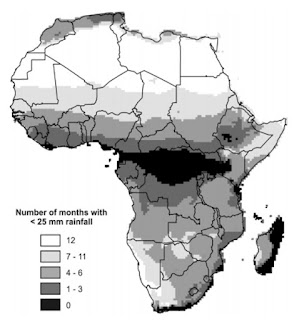In this blog, there have been a variety of discussions on
how to increase food production and make water use more efficient in order to
meet food demands in Africa. This has been interlinked with the effect climate
change has on food insecurity. These are all important but they only focus on
improving food production. The concept of ‘virtual water’ is an alternative to
these ideas. Virtual water is a term used to explain ‘how physical water scarcity in countries in arid regions is relaxed by importing water-intensive commodities.’ The concept is simple as it suggests that countries that have
insufficient water resources should import high water demand crops to avoid
this drain on their domestic water. As with all concepts, there are benefits
and drawbacks.
Figure 1 below shows the virtual water balance by country
and the major flows of virtual water. Focusing specifically on Africa, the
northern and southern areas tend to import more virtual water than the lower
latitude African nations. Much of northern and southern Africa is desert and
this highlights their need to import water intensive crops. Importantly from
this map, all the major flows of virtual water between countries avoid Africa
entirely.
 |
| Figure 1: Virtual water balance by country and direction of major
flows (1996-2005) |
Virtual water in
Africa
Virtual water is a key component of addressing food insecurity
across Africa. African countries predominantly trade in virtual water with other African countries rather than the rest of the world. The biggest
connection is between two southern African countries, Zimbabwe and South Africa. It is important to note that countries in Africa frequently trade with
their neighbours. The connectedness between African countries is important
because virtual water trades can be mutually beneficial and meet different
needs in different countries. For example, countries can specialise in certain
crops that grow well in their climate without having to worry about providing a
variety of crops.
There is a tentative link between increasing openness to virtual water trade and decreasing undernourishment (which is a proxy for food security). This would suggest that virtual water security is an effective
method for reducing food insecurity. Globally there is a trend that, as crop exports increase, water efficiency also increases but Africa is an anomaly to this trend. Because of this, the importance of virtual water is raised in
Africa due to the shortcomings of other methods to reduce food insecurity. It
is likely to be the case that funding is the key reason why water efficiency
has not increased as much of the technology is too expensive for small-scale
farmers.
A 2013 paper, suggested that virtual water imports may
lead to overpopulation in some areas which may make these areas unsustainable.
Increasing populations of areas with insufficient resources puts further strain
on virtual water trade and leaves the population vulnerable to agricultural
changes worldwide as they are reliant on crops produced in a variety of
countries around the world. The MENA region (Middle East and North Africa) has been identified as a region where overpopulation is driving an increase in food demands and thus increased food insecurity. Population has quadrupled between 1950 and 2000. In addition, there has been poor water management and declining water quality. This illustrates that countries should not be
over-reliant on virtual water trade.
Overall, it is clear that virtual water has a key role to
play in meeting water and food demands in Africa. It is vital to remember that
it is not a complete solution and over-dependence of virtual water trade can
bring about other problems such as over-population. Africa as a continent does
not have to be entirely reliant on increasing food production and raising
efficiency levels to meet food and water demands, virtual water trade can help
too.













